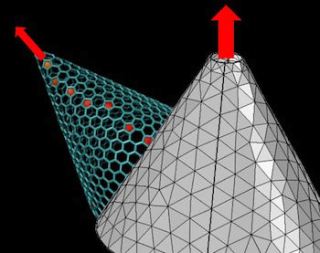Rice Researchers Determine Electrical Properties of Nanocones and Other Graphene Forms
Flexing graphene may be the most fundamental method for controlling its electrical properties, according to calculations by theoretical physicists at Rice University and in Russia. The researchers at the Rice lab of Boris Yakobson in association with Moscow researchers discovered that the effect could possibly occur in nanocones and also other graphene forms.
The researchers found that the so called electronic flexoelectric effect which involves manipulation of electronic properties a graphene sheet can be achieved by twisting the graphene in a particular way.
The work could be useful for applications that involve elements in flexible touchscreens or memory chips that store bits by tweaking the electric dipole moments of carbon atoms.
A typical graphene is an atom-thick sheet of carbon that is conductive in nature. The electrical charges of the atoms balance each other across the plane. However, on the concave side, the graphenes curvature compresses the electron clouds of the bonds while it expands them on the convex side. This results in the alteration of electric dipole moments that regulate the way in which polarized atoms interact with external electric fields.
The findings of the research published in the American Chemical Societys Journal of Physical Chemistry Letters suggest that it is possible to determine the flexoelectric effect of graphene, which is in the form of a cone of any length or size.
The researchers computed the dipole moments for single atoms in a graphene lattice using density functional theory and calculated their cumulative effect. They showed that their technique can also be applied to other complex shapes including wrinkled sheets or distorted fullerenes to calculate the effect. They have also analyzed most of these shapes.
While the dipole moment is zero for flat graphene or cylindrical nanotubes, in between there is a family of cones, actually produced in laboratories, whose dipole moments are significant and scale linearly with cone length.
Yakobson
He added that carbon nanotubes are seamless graphene cylinders which do not exhibit a total dipole moment. The vector-induced moments cancel out each other when not in zero.
However, this is not the case with a cone. Here, the balance of positive and negative charges differs for each atom owing to slightly varying stresses on the bonds with changes in the diameter. The researchers also pointed out that the atoms in the edge of the cone also contribute electrically. Further, analysis of two cones that are docked edge-to-edge made them cancel out, thereby making the calculations simple.
One possibly far-reaching characteristic is in the voltage drop across a curved sheet. It can permit one to locally vary the work function and to engineer the band-structure stacking in bilayers or multiple layers by their bending. It may also allow the creation of partitions and cavities with varying electrochemical potential, more ‘acidic’ or ‘basic,’ depending on the curvature in the 3-D carbon architecture.
Yakobson
The studys co-authors include Alexander Kvashnin, a graduate student at the Moscow Institute of Physics and Technology and a researcher at the Technological Institute of Superhard and Novel Carbon Materials, and Pavel Sorokin, who has appointments at the Technological Institute of Superhard and Novel Carbon Materials and the National University of Science and Technology, Moscow. Both are former members of the Yakobson Group at Rice.
Yakobson is Rices Karl F. Hasselmann Professor of Materials Science and NanoEngineering, a professor of chemistry and a member of Rice’s Richard E. Smalley Institute for Nanoscale Science and Technology.
The research work was supported by the Russian Federation, Moscow State University, the Russian Academy of Sciences and the Air Force Office of Scientific Researchs Multidisciplinary University Research Initiative. The National Science Foundation and the Air Force Office of Scientific Research supported the work at Rice.

